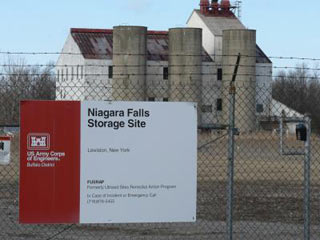Next story: Bethany Moore: Buffalo gal returns in A Chorus Line
Observed while remembering the National Aniline and Dye Company
Odds & Ends
■ In other Common Council news, we’re told that belleagured Ellicott District Councilmember Brian Davis was back on the job Tuesday, accompanied by a bodyguard He’d been absent from meetings again last week. Buffalo News reporter Jim Heaney wrote on April 12 that Davis had missed a third of his meetings since the new year; he has been missing meetings at roughly an equal rate since then. Davis has indicated that he has a health issue, though he has not disclosed its nature or provided a doctor’s orders.

■ Senators Chuck Schumer and Kristen Gillibrand announced on Tuesday that the federal stimulus package contains $8 million for new work on the 191-acre Niagara Falls Storage Site, the Lewiston facility where the US Army Corps of Engineers stands guard over radioactive waste dating back to the Manhattan Project and the early days of the Atomic Energy Commission.
The waste lay for decades in open pools and leaking barrels spread around 12 square miles of former farmland once called the Lake Ontario Ordnance Works, a federal reserve acquired by the War Department during World War II. In the early 1980s, the Department of Energy and subsequently the Army Corps oversaw a remediation effort, which led to the waste—including radium, thorium, uranium, plutonium, and who knows what else—being concentrated and buried on the much smaller NFSS. When it was first built, federal officials said the containment facility—which consists essentially of the basements of demolished buildings, filled with radioactive slurry and capped with clay—could safely hold the radioactive waste for 25 years before there was danger of leaking. They called it and “interim” measure. The idea was that the waste would eventually be removed and shipped to a premanent nuclear waste storage facility. But no such facility has came into existence—see: Yucca Mountain controversy—nor will one be opened in the foreseeable future. In recent years, the Army Corps has reversed itself, saying the containment structure ought to be considered permanent. A federal law change in 2005 reclassified the hottest materials buried at the NFSS, making them legally eligible to remain interred there.
Most of the $8 million will be used to demolish Building 401 (pictured), under which is apparently buried more hazardous waste. The nature of that waste has not been revealed, but it’s safe to bet it’s radioactive.
The rest of the money will be used to update the site’s security system and to create a digital record-keeping system. So it sounds like that 25-year temporary storage site is indeed becoming a permanent fact in the ground.
■ In related news, the Niagara Gazette reported on Tuesday that Niagara Catholic High School will remain open next year and “for the long haul,” despite facing a projected $250,000 deficit this year and an even bigger shortfall next year. The school’s board members credited aggressive fundraising and faculty concessions for closing those financial gaps.
Long-term trends argue against the school’s future: enrollment continues to drop, and the Diocese of Buffalo continues to cut aid to Catholic schools throughout the region.
And if that’s not tough enough, look at the school’s location: It lies just a couple thousand feet from the smokestack of Stratcor Metals, which produces vanadium products. Stratcor sits in part of the footprint once occupied by Union Carbide’s Electromet plant, an early and prolific source of uranium metal for the atomic weapons and reactors. In the seven years between 1965 and 1972, according to the Department of Energy, Union Carbide companies at Royal Avenue and 47th Street generated 505 tons of radioactive waste, carrying 9,212 pounds of uranium oxide, and 1,293 pounds of thorium oxide. All of that waste was buried on site in 55-gallon drums, piled in a ditch 20 feet deep and covered with four to five feet of soil, nearby the Mid-town Little League baseball diamonds. There is no public record of that waste ever having been recovered; the drums in which it was buried certainly have outlived their usefulness.
There has never been a comprehensive health study to determine the impacts of all the hazardous waste with which Niagara County residents live, especially around dump sites and industrial corridors. So we’re left with anecdotes and obituary pages and guesswork. Consider the twin brothers Anthony and Carlo Conti, who both attended Bishop Duffy, now Niagara Catholic, and played sports on its athletic fields, which today are sponsored by Covanta Energy (formerly American Ref-Fuel) and the Allied (formerly BFI) 56th Street landfill facility. As adults, Carlo coached there and Tony took care of the fields, cutting the grass, striping the ball diamonds and football field. Carlo died first, then Anthony, both of cancers.
There’s no way to know for certain that the Conti’s brothers’ cancers were caused by years of exposure to hazardous wastes produced, buried, and forgotten at nearby industrial sites. Maybe, maybe not. Absent a thorough environmental history of the region, and subsequently the appropriate health studies, the question, like the school, is here for the long haul.
—geoff kelly & louis ricciuti
blog comments powered by Disqus
|
Issue Navigation> Issue Index > v8n18 (Week of Thursday, April 30, 2009) > The News, Briefly > Observed while remembering the National Aniline and Dye Company This Week's Issue • Artvoice Daily • Artvoice TV • Events Calendar • Classifieds |









 Current Issue
Current Issue